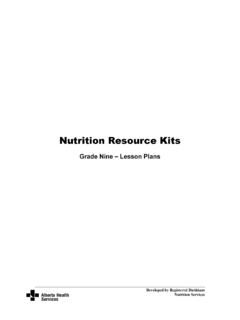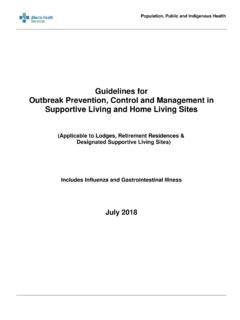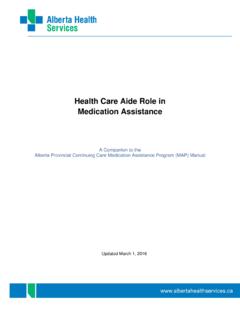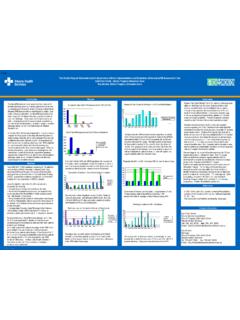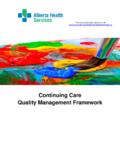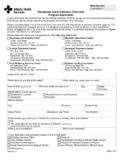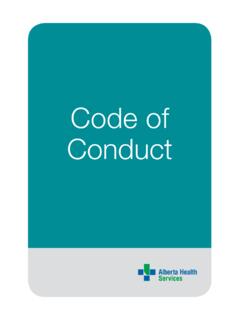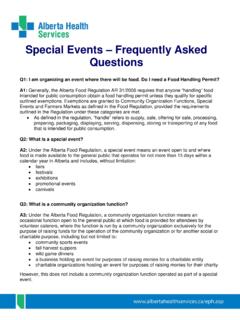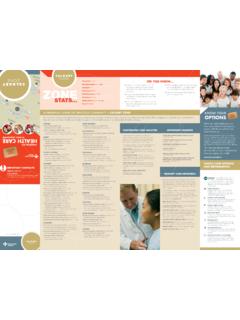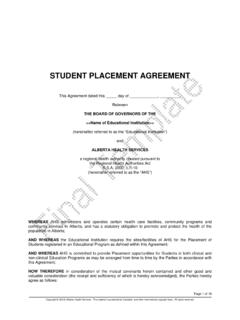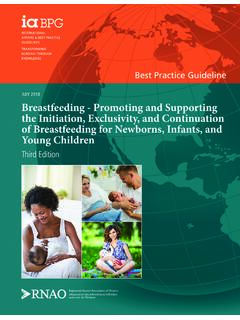Transcription of Nutrition Guidelines for Healthy Infants and Young Children
1 Nutrition Guideline Healthy Infants and Young Children GI Function: Management of Constipation Applicable to: Nurses, Physicians and Other Health Professionals For Professional Reference Only March 2015 Page Nutrition Guideline: Healthy Infants and Young Children Management of Constipation Recommendations Parents and caregivers should be educated about the wide variation in normal bowel movements in Infants and Children to avoid unnecessary anxiety and/or medical consultation. Evidence does not support any particular foods as being the cause of constipation. However, if high intakes of any foods create a lack of fibre or fluid intake, then constipation may result. Refer to the constipation decision trees on pages ( Infants 0-12 Months) and ( Children Age 1 Year and Older) for scientific evidence and the best practice for the assessment of constipation, dietary management at the onset of constipation and/or prevention of chronic constipation.
2 For Infants and Children who do not respond to recommended management Guidelines , who have chronic constipation or who present with Red Flags (see below), referral to a physician is recommended to rule out underlying medical problems and/or to provide other treatment. Non-dietary treatment ( laxatives, mineral oil, lactulose) is beyond the scope of this guideline and should be discussed with a physician. Health Benefits This guideline provides assistance to health professionals in the assessment of constipation, and the dietary management at the onset of constipation and/or to help prevent chronic constipation in Healthy term Infants and Children . Constipation can also be a prominent symptom in Children who have underlying medical conditions such as Although this guideline was not specifically created for preterm Infants , it is reasonable to apply the dietary advice in this guideline to Healthy preterm Infants experiencing constipation.
3 Healthy Stool Patterns in Infants and Children Parents and caregivers should be educated about the wide variation in normal bowel movements in Infants and Children to avoid unnecessary anxiety2 and/or medical It is normal for stool patterns to vary from infant to Stool consistency can vary according to what an infant is fed (breast milk, type of formula,3,4 type of solid food5), and stools tend to become harder as Infants and Children get ,6,7 In exclusively breastfed Infants at one month of age, stool is typically mushy, although watery stools can From birth to six months of age, runny and pasty stools occur with equal frequency, while liquid stools occur on A picture stool diagram such as the Bristol Stool Form Scale can be helpful for standardizing stool Refer to the Bristol Stool Form Scale in Appendix 1. Note: Even though runny stools (similar to types 5 7 in the Bristol Stool Form Scale) could be considered diarrhea in adults,10 this is normal for exclusively breastfed Stool Frequency 1st Week after Birth For information on stool patterns of newborn Infants , refer to Alberta Health Services (AHS), Public Health Nursing Practice, Maternal / Newborn Manual - Section 2: Newborn on Insite.
4 Margin Nutrition Guideline Healthy Infants and Young Children GI Function: Management of Constipation Applicable to: Nurses, Physicians and Other Health Professionals For Professional Reference Only March 2015 Page Nutrition Guideline: Healthy Infants and Young Children Management of Constipation One to Four Weeks after Birth Average bowel movements are two11 to three3,12 per day for formula fed Infants ; an average of four per day for breastfed Infants from one to two weeks of The number of bowel movements tends to decrease with age. One to Two Months of Age The frequency of bowel movements tends to decrease with age in both breastfed and formula fed Infants ,3,5,7,13 for term and preterm Infants , especially after one month of ,5,6 Breastfed Infants display greater variability in stool frequency than formula fed o Exclusively breastfed Infants typically have more frequent bowel movements than formula-fed infants2,3,4,6,12 in the first two12 to eight3 weeks after birth.
5 O In some Healthy exclusively breastfed babies over six weeks of age with normal growth and development, bowel movements may be infrequent and soft,7,15,16 ranging from one every two days to two weeks,15 or even one every three or four ,13 These infrequent stools can be normal in Infants who are effectively transferring milk and appropriately gaining weight; however, a physician should be consulted if there is no bowel movement for 2 weeks, and/or red flags are present as output coupled with weight issues or other red flags may be early indicators of poor feeding/illness missed by parents. (See "Red Flags", below for more information). Two Months to Three Years of Age Infants and Children commonly whether term or preterm have approximately one6,12 to two3,5,7 bowel movements per day, but many Infants have fewer than Three Years of Age and Older Approximately one bowel movement per day is usual3,5 but it can be as few as three per Note: For more information on Healthy Stools in Infants from birth to two months of age, please refer to the AHS, Public Health Nursing Practice, Maternal/Newborn Manual found on Insite.
6 Definition of Constipation The wide variation in normal stool patterns in Infants and Children makes it difficult to define constipation;17 and has resulted in a variety of definitions. Since the frequency of bowel movements varies from infant to infant ,3 can vary significantly in exclusively breastfed Healthy babies17 and is dependent on age,3,5,7,13 it has been suggested by some that constipation should not be defined by the frequency of bowel movements or by symptom Most Guidelines , however, include the frequency of bowel movements1,13,16,18 and the duration of symptoms1,13,18 in their definitions of constipation. This Nutrition Guideline considers a combination of these definitions. For this guideline, constipation is considered to be bowel movements that are hard and dry, and may be difficult or painful to Infrequency may also be a factor but is dependent on age and if an infant is exclusively To help with establishing if constipation is present, refer to Appendix 1.
7 Nutrition Guideline Healthy Infants and Young Children GI Function: Management of Constipation Applicable to: Nurses, Physicians and Other Health Professionals For Professional Reference Only March 2015 Page Nutrition Guideline: Healthy Infants and Young Children Management of Constipation Signs that Constipation Could Be Related To a Medical Condition ( Red Flags ) If any of the following symptoms exist, refer to the child s physician: fever;1 abdominal distension;1 anorexia;1 nausea;1 vomiting;1 weight loss;1 poor weight gain;1 blood in stool;1 diarrhea;1(the frequent passage of loose or watery stools, usually accompanied by abdominal cramping and urgency16); failure to thrive;1 constipation in the first few weeks after Signs and Symptoms of Chronic Constipation1 A child exhibiting any of the following symptoms of chronic constipation should see a physician for treatment: extremely large bowel movements; fissures (small, painful tears in the skin around the anus); hemorrhoids; involuntary release of urine; increased urinary tract infections; overflow diarrhea (occurs when the stools become too hard to pass and fecal fluids flow around the blockage.)
8 The leakage consists of fluids only, is generally the color of feces, and is not accompanied by abdominal pain. Urgency in older Children is often noted as difficulty in reaching the toilet before it is expelled). Constipation in Infants 0 12 Months Practical Considerations In Infants , any change in diet may result in stool inconsistency and/or a change in the frequency of bowel movements. This includes: changing from breast milk to formula or cow s milk;19 introducing new formulas;19 introducing complementary Formula with iron does not cause constipation and is important to prevent There is no difference in the number and consistency of stools between Infants fed a low-iron or a high-iron does not support any particular foods as being the cause of constipation. However, if high intakes of any foods create a lack of fibre or fluid intake, then constipation may Nutrition Guideline Healthy Infants and Young Children GI Function: Management of Constipation Applicable to: Nurses, Physicians and Other Health Professionals For Professional Reference Only March 2015 Page Nutrition Guideline.
9 Healthy Infants and Young Children Management of Constipation Management of Constipation In exclusively breastfed Infants , hard stools are extremely If an exclusively breastfed infant has dry and hard stool, hydration should be assessed and the infant referred to a The management of constipation in Infants is supported by limited evidence and expert Evidence is lacking to suggest the most effective amounts, frequency of dosing, or the age at which dietary modifications can safely be Common recommendations include increased intake of both absorbable (digestible) and non-absorbable (non-digestible) carbohydrate, sorbitol-containing juices, water and dietary fibre to maintain soft stools. Refer to the Constipation Decision Tree for Infants 0-12 Months, page , for the dietary assessment and management of infant constipation. Constipation in Children Age 1 Year and Older Practical Considerations Constipation can make a bowel movement painful, so the child may try to prevent having one.
10 Once a child begins to be afraid of passing bowel movements, the cycle of chronic constipation has begun and bowel movements become more and more Bowel movements in Children age one and older may change in consistency and frequency when a child: ignores the urge to have a bowel movement, which is often done out of embarrassment to use a public bathroom, fear or lack of confidence in the absence of a parent, or not wanting to take a break from play;20 does not consume adequate fibre or fluids, or achieve appropriate physical Refer to Appendix 2 for fluid Guidelines . Review client handout for fibre and activity recommendations. If constipation does occur, it is most common during toilet training, and after starting Evidence does not support any particular foods as being a cause of constipation. However, if high intakes of any foods create a lack of fibre or fluid intake, then constipation may Management of Constipation The management for temporary constipation in Children involves:20 o establishing open communication with the child; o establishing good habits and regular bathroom times; o diet modifications and increasing physical activity.
